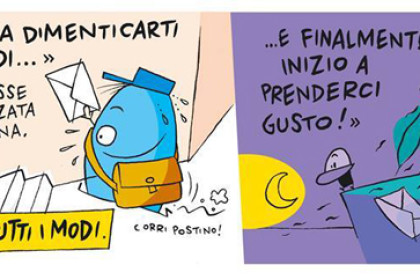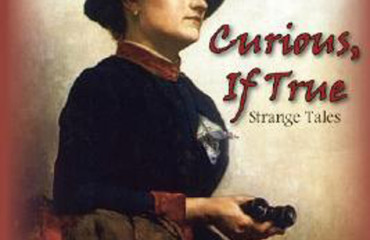
Palmiro was born on a November night in 1992. He was born by accident. Sauro was trying to draw The Ugly Duckling and the sketches of Pino, a cute and unconvincing doll, appeared Palmiro: a small duckling, ugly and black. But duck, like those of Carl Barks. It was love at first sight.
Created for the weekly comic, in May 1993 it was published in Comix, initially as part of a series of humor strips on various topics titled Novelle. A few months later it is stated as a successful character. Champion of who fall in love with love itself.
Palmiro – The Pride of Far Away Girlfriends is by definition a comic strip, the comic in its original form appeared in the New York newspapers of the late nineteenth century. Used to comment on news, events or misdeeds, the strip is a sequence of a few frames, attractive and easy to read, designed to make the reader laugh.
Irascible and lonely, Palmiro is the unfortunate protagonist of a complicated love story, endless and unreasonable. A love story from a distance. The Far Away Girlfriend is a free figure who likes to live her own experiences and retell them in frank, poignant letters to her beloved. In reading those words the drama of Palmiro, crushed and humiliated by a strong and independent female figure, “protagonist of his time”, a revolutionary figure in the panorama of Italian custom of those years, the forerunner of what were then some female icons at the end of the century.
The style is one of the most original of the national scene, a spearhead of Italian comics. The lines are crisp and essential in the definition of spaces and objects. The simplicity of the stretch and deformation of the lines in perspective and in the geometries are the result of curious and cultured research. Palmiro is one of the most intelligent comics of the nineties thanks to the strong research, and inspired by the surreal settings of George Herriman’s Krazy Kat, from abstract studies of Kandinsky and Klee, citing the graphic style of Javier Mariscal.
When you ask what kind of love Sauro used to tie Palmiro and The Far Girlfriend, he says: “The love between Palmiro and the Far Away Girlfriend is complex. It is necessary to give simple answers to complex questions: I do not know. I’m also asking the professionals who form a kind of insecure avoidant attachment but still have not got it right. So many times Bolivar (the cactus) and me, in front of a bottle of mezcal (within which Palmiro is a worm), we talked about it and at the end (of the bottle) have always decided to let the story take its natural course. Love is a natural urge. As drinking or eating. In the end, a very simple mechanism. But if the two main actors in a love story are complex beings, and grew up immersed in a world that is increasingly diverse and indecipherable, it is obvious when variables increase everything becomes more and more a mess! Hardly a surprise, isn’t it?”
The stories of Palmiro are collected in the books My Name is Palmiro 1, 2 and 3, in the series À la recherche du temps perdu, a publishing project now published by Sauro Ciantini Editore.
 English
English  Italiano
Italiano 



